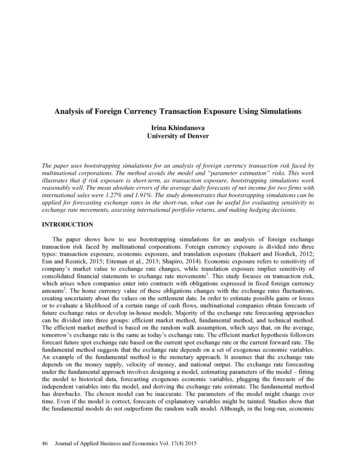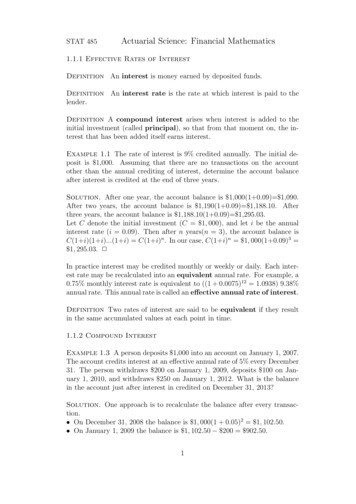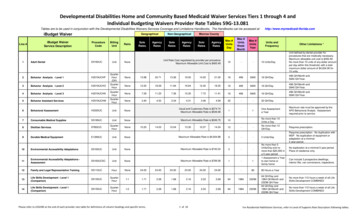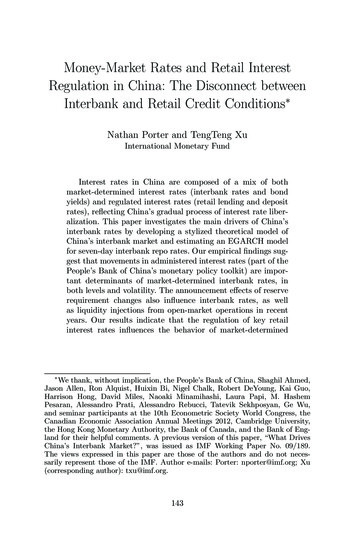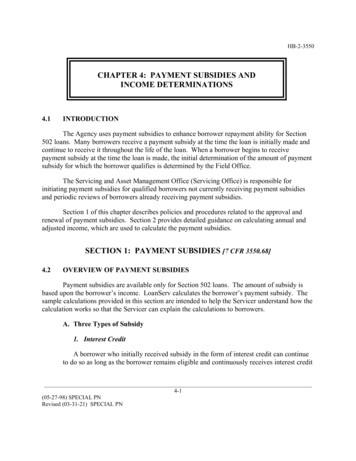
Transcription
REFERENCE INTEREST RATES:ROLE, CHALLENGES AND OUTLOOKARTICLESReference interest rates are frequently used interest rates that link payments in financial contractsto standard money market interest rates. They serve as benchmarks for determining payments onwholesale and retail loans, on floating rate notes and on derivatives contracts aimed at managinginterest rate risk. They are also entrenched in the global financial system via their usage in thevaluation of financial instruments and as a basis for performance measurement. This articlereviews the role traditionally played by reference rates, with a particular focus on the role thatEURIBOR plays in the monetary policy transmission mechanism in the euro area. Based on therecent evidence of manipulation of reference interest rates and declining activity in the underlyingmarket, the article summarises the ECB’s views on the current debate on the possible options toreform these reference rates, as well as the initiatives taken by the ECB to establish commonlyagreed principles that will strengthen the existing governance framework and to develop a nextgeneration of reference rates that are better anchored to observable transactions and morerepresentative of the underlying market conditions. It also presents some preliminary results of thetransaction data collection exercise that was carried out by EURIBOR-EBF and supported by theECB in order to assess the scope for a transaction-based reference rate that could act as a crediblesubstitute for EURIBOR. The article concludes that, while the reforms already implemented or tobe introduced represent significant progress in terms of strengthening the governance framework,restoring credibility and reducing the risks of manipulation, further steps need to be taken toexplore alternative reference rates that are more transaction-based and that could be a potentialsubstitute for the current reference rates. The article also concludes that reference interest ratesreflecting banks’ unsecured funding costs will continue to play an important role, although theywill probably need to be complemented by alternative reference rates so that users can choosereference rates that better match their needs.1Reference interest rates:role, challenges and outlookINTRODUCTIONReference interest rates (in particular TIBOR1, LIBOR2 and EURIBOR3 are interest rates thatlink payments in a financial contract to standard money market interest rates. Given the growingimportance of these reference interest rates within the financial community over time, thetransmission of monetary policy is significantly influenced by the link between key referenceinterest rates and the central banks’ key policy interest rate. Since the 1990s reference interest ratesbased on unsecured interbank lending and borrowing have become dominant, as they facilitate themanagement of banks’ funding risks owing to the role that banks play in credit channeling. This hasmade reference rates an essential tool in the transmission of monetary policy decisions along theyield curve, thereby affecting the investment decisions of many economic agents.The allegations that have emerged since 2012 relating to the manipulation of key reference ratessuch as TIBOR, LIBOR and EURIBOR have triggered a widespread debate on the appropriatenessof the process used to set reference interest rates. Yet this debate is supplemented by a morefundamental question on the continuous representativeness of the interest rates used at present,given the ongoing decline in the underlying market volumes and higher concentration. The ECBbelieves that there is significant scope to reform these reference rates further. Taking into account123TIBOR stands for “Tokyo interbank offered rate”. Since 1995 it has been administered by the Japanese Bankers’ Association. For furtherinformation, see http://www.zenginkyo.or.jp/en/tibor/the jba tibor/index.htmlLIBOR stands for “London interbank offered rate”. It has thus far been administered by the British Bankers’ Association, butits administration will be transferred to NYSE Euronext Rates Administration Limited by early 2014. For further information,see http://www.bbalibor.com/newsEURIBOR stands for “euro interbank offered rate”. Since 1999 it has been administered by EURIBOR-EBF. For further information, seewww.euribor-ebf.euECBMonthly BulletinOctober 201369
the importance of these reference rates in the implementation and transmission of monetary policy,any reform should distinguish between short-term, governance-enhancing measures aimed atimmediately increasing market confidence in these rates and more medium to long-term measuresaimed at making reference rates more transaction-based and more representative.The aim of this article is thus threefold. First, to recall the purpose and role of reference interestrates such as EURIBOR in the euro area and their importance from a monetary policy perspective(see Section 2). Second, to explain the background behind the current debate on the appropriatenessand representativeness of the reference interest rates (see Section 3). Third, to present the variousinitiatives taken by the official sector, including the Eurosystem, to enhance the integrity ofcurrent reference interest rates and to encourage the adoption of more transaction-based ones(see Section 4). In conclusion, the article draws some conclusions on what has been achieved thusfar and the tasks that lie ahead (see Section 5).2TRADITIONAL ROLE OF REFERENCE RATESTo understand the importance and social value of reference interest rates such as TIBOR, LIBORand EURIBOR, it is first essential to recapitulate the evolution of banks’ funding over time, whichin the 1990s gradually moved from a bank-based financial system towards a market-based financialsystem. Reference interest rates, such as LIBOR or EURIBOR’s predecessors in the euro’s legacycurrencies, were initially created in the late 1980s in the context of syndicated loans as a moretransparent and cost-efficient way for banks to pass on their funding costs to their customers byadding a spread to a reference rate representative of their marginal funding costs. The standardisationof the pass-through rate in financial contracts also led to the emergence of derivatives, initially inthe form of forward rate agreements (FRAs) and then swaps. These derivatives allowed banks tooffer fixed rate loans while hedging their variable funding costs.2.1 ROLE, NATURE AND CALCULATION OF REFERENCE RATESReference interest rates are snapshot assessments of certain market rates. Traditionally their rolehas been to determine the pay-offs of standardised financial contracts by applying a formula to thevalue of one or more underlying asset or price.Based on the ESMA-EBA Principles for Benchmark-Setting Processes in the EU,4 several differentroles in the rate-setting process can be identified. First, there is the so-called reference rateadministrator, which is the legal entity that sponsors the creation and operation of the reference rate.It is also responsible for the calculation of the reference interest rate, as well as the methodologiesand governance of the rate-setting process. Second, there are the contributors, i.e. the legal entitieswhich contribute to the reference data used in the reference rate calculation process. Third, there isthe calculation agent, which is the legal entity that calculates the reference rate based on the datasubmitted by the contributors. This entity may coincide with the administrator or be a third partyto which the administrator has assigned this role. Finally, there is the publisher, which is the legalentity that makes the reference rate values available via publicly accessible media.Based on the data used to calculate the reference interest rates, a distinction can be made betweentransaction-based reference rates, which are based on the rates applied to actual transactions, and470For further information, see www.esma.europa.eu/system/files/2013-659 esma-eba principles for benchmark-setting processes inthe eu.pdfECBMonthly BulletinOctober 2013
ARTICLESquote-based reference interest rates, which are based on estimates of the rates at which transactionscan be executed. Depending on the data submitted, unsecured market reference rates can be furtherdifferentiated between reference rates for lending and borrowing.Reference interest rates:role, challenges and outlookFor example, in the specific case of the euro area and EURIBOR, EURIBOR-EBF5 is thebenchmark administrator, while Thomson Reuters is the calculation agent and publisher that usesdata submitted by a panel of contributing banks. EURIBOR is a quote-based reference rate and iscalculated as a trimmed mean after the elimination of the top and bottom 15% of the contributions.Contributions are based on the following definition: “EURIBOR is the rate at which Euro interbankterm deposits are offered by one prime bank to another prime bank within the EMU zone, and ispublished at 11:00 a.m. (CET) for spot value (T 2).”6 It does not necessarily refer to the interbanklending rates of the contributing bank, but rather to those at which euro interbank term deposits areoffered by one prime bank to another prime bank within the euro area.7TIBOR, administered by the Japanese Bankers Association, is based on quotes the panel ofcontributing banks provide on the basis of what “they deem to be prevailing market rates, assumingtransactions between prime banks”.There are two types of TIBOR rate, namely the Japanese YenTIBOR and the Euroyen TIBOR, depending on whether the quotes provided refer to the Japaneseunsecured call market or the Japanese offshore market.In contrast with EURIBOR and TIBOR, LIBOR, which has so far been administered by the BritishBankers’ Association (BBA)8 and is calculated and published by Thomson Reuters, is based on theanswers provided by a panel of banks to the question: “At what rate could you borrow funds, wereyou to do so by asking for and then accepting inter-bank offers in a reasonable market size justprior to 11 a.m.?”. Therefore, submissions are based on the lowest perceived rate at which a bankon a certain currency panel could access the interbank money market and obtain sizeable fundingfor a given maturity. LIBOR refers to the estimated borrowing costs charged to contributing banksand may therefore have a stronger signalling effect on the creditworthiness of these banks. Suchsignalling effects may have increased the incentives to manipulate individual submissions duringthe financial crisis.The euro overnight index average (EONIA) is a transaction-based interest rate used for the euroarea overnight segment of the money market. It is calculated by the ECB, with EURIBOR-EBF asthe benchmark administrator and Thomson Reuters as the publisher, as a weighted average of theinterest rates on unsecured overnight lending transactions denominated in euro reported by a panelof contributing banks. The ECB’s role as the calculating agent of EONIA stems from the high levelof confidentiality required for the handling of the submissions of individual bank transaction data,as well as the need to ensure that the data are treated with the utmost confidentiality by an impartialthird party. The transaction-based nature of the submission minimises the extent of the subjectivityimplicit in quote-based systems, reduces the risk of manipulation – although it does not eliminateit – and facilitates the ex post validation process.5678EURIBOR-EBF is an international non-profit-making association that was founded in 1999 with the launch of the euro. Its members arethe national banking associations of those EU Member States that have adopted the euro.See r.htmlThe concept of a prime bank has recently been clarified in the Code of Conduct as “a credit institution of high creditworthiness for shortterm liabilities, which lends at competitive market related interest rates and is recognised as active in euro-denominated money marketinstruments while having access to the Eurosystem’s (open) market operations.” The concept of an interbank deposits has also beenclarified in the Code of Conduct as “a cash deposit between two credit institutions, maturing by one year from inception.”On 9 July 2013 the board of the BBA voted unanimously to approve the transfer of the administration of LIBOR to NYSE Euronext RatesAdministration Limited. The BBA will hand over the administration of LIBOR to that entity following approval by the United Kingdom’sFinancial Control Authority. The transition to the new administrator is expected to be completed in early 2014.ECBMonthly BulletinOctober 201371
2.2 RELEVANCE OF REFERENCE RATES FOR EURO AREA MARKETSThrough hedging activities (via swap and FRA contracts), there is a close link between cash (spotand term) deposit interest rates and the derivatives segments of the money market. Transactions inthe cash and derivatives segments of the money market (in the euro area and other jurisdictions) areconducted mainly over the counter (OTC), which makes it difficult to trace the rates and volumesof the transactions made. This, in turn, increases the importance of having a reliable benchmarkreference on a term that is representative of the funding conditions for financial contracts (retailloans, wholesale banking activities, syndicated loans) as well as OTC financial derivatives (FRAs,short and long-term swaps, swaptions) and exchange-traded financial derivatives (futures contractsand options on those futures contracts).9In the case of the euro area, EONIA is the usual reference interest rate for euro overnight indexedswaps (OISs). EURIBOR serves as a pricing benchmark for variable rate loans and mortgages, andis the reference rate for most interest rate swaps (IRSs) and other OTC-traded derivatives, such asFRAs, and exchange-traded short-term interest rate futures contracts. The creation and trading ofthese instruments has developed rapidly on account of their potential for leveraging and hedginginterest rate risk.10According to the latest data available from the BIS, at the end of 2012 the notional amount11outstanding of single-currency OTC interest rate derivatives (FRAs, swaps and options) was USD489.7 trillion.12 Of this total, the largest shares by currency were the notional amounts referenced toeuro interest rates (equivalent to USD 187.4 trillion, of which USD 137.6 trillion were IRSs, USD25.6 trillion FRAs and USD 24.2 trillion interest rate options), which were greater than the amountsreferenced to US dollar rates (USD 148.7 trillion). There is broad consensus in the market that themain reference rate underlying euro interest rates is EURIBOR, although there is no mention of thisin the BIS data. With regard to exchange-traded interest rate derivatives, data published by Euronextshow that the total notional amount of the three-month EURIBOR futures contracts traded on theLIFFE exchange in London in 2012 amounted to 178.7 trillion and that of EURIBOR options onfutures was 70.7 trillion. These contracts are primarily, although not exclusively, used by banksto hedge a significant part of their balance sheet against interest rate risk while performing theirmaturity transformation function.However, the traditional role of reference interest rates based on the unsecured interbank market iscurrently being challenged by the developments that have occurred since the onset of the financialcrisis. First, the relationship between market reference rates and the individual cost of funding hasbeen significantly weakened, as the latter reflects more frequently country-specific or bank-specificfactors. Second, in terms of banks’ funding, there has been a gradual, albeit significant, shift fromthe unsecured to the secured segment. In this regard, declining volumes and the higher concentrationhave called into question the representativeness of reference interest rates.13 These developmentsmay undermine the benefits of using reference rates or lead banks to charge higher spreads on91011121372For a full description of the LIBOR-type fixings, see Gyntelberg, J. and Wooldridge, P.D., “Interbank rate fixings during the recentturmoil”, Quarterly Review, BIS, March 2008.Options now exist on both IRSs and futures contracts, which are the starting point of the price formation mechanism of market-impliedvolatilities for euro interest rates.The notional value is the nominal amount of the asset, reference rate or index underlying a derivative financial instrument. It is differentfrom the market value that results from the netting of the respective obligations of the buyer and of the seller of the contract, whichrepresents the replacement cost of a given contract transacted at a given price at any point in time.BIS data covering the G10 countries since the end of June 1998, as well as Australia and Spain from December 2011.See also the discussion in Brousseau, V., Chailloux, A. and Durré, A., “Fixing the Fixings: What Road to a More Representative MoneyMarket Benchmark?”, IMF Working Paper, No. 13/131, May 2013.ECBMonthly BulletinOctober 2013
ARTICLESmarket reference rates to compensate for adverse changes in their own refinancing costs and hedgetheir basis risk.Reference interest rates:role, challenges and outlookThe volatility of banks’ credit risk premia has also highlighted the credit risk component embeddedin these rates, making them less appropriate as a proxy for risk-free rates, as they used to beperceived. In turn, the growing awareness of the credit risk component embedded in traditionalunsecured market reference interest rates has pushed up demand for reference interest rates, suchas OISs, to be as risk-free as possible and not to reflect the term, liquidity and credit risk premiaembedded in traditional unsecured market reference interest rates. In particular, such OIS rateshave increasingly been seen as more appropriate for evaluating centrally cleared standardised OTCderivatives and OTC derivative positions based on comprehensive collateralisation arrangements.2.3 IMPORTANCE OF REFERENCE INTEREST RATES FROM THE MONETARY POLICY PERSPECTIVEFrom the ECB’s perspective, EURIBOR and EONIA are of crucial importance for the efficientfunctioning of both the euro area and the international financial system. Their role has evolved overtime, together with their standardisation and the increased liquidity and availability of financialinstruments referring to them. Monetary policy decisions and market expectations of the futurepath of policy rates are directly reflected in the interest rates that serve as a reference for highlyliquid and standardised derivative products, such as FRAs, futures and IRSs. In turn, these form thebasis for the pricing of various, usually less liquid, marketable debt instruments, thus influencingfinancing and credit conditions.Given the crucial role of EONIA and EURIBOR in the formation of both euro money marketinterest rates and market expectations regarding the future values of short-term interest rates, theyalso play an essential role in the interest rate channel, which transmits the monetary policy stancealong the yield curve. Over time, they have therefore gained a social function and are now a publicgood. Both interest rates help to ensure a homogeneous pricing benchmark for the entire moneymarket yield curve across the euro area.Today, the existing reference interest rates for the unsecured market are still used as a standard inthe financial industry, despite the decreasing turnover in the underlying market. As reported in thetable, almost 60% of total loans to non-financial corporations in the euro area were floating rateloans at the end of March 2012; their interest rates were hence referenced mostly to EURIBOR. Atthe same time, the proportion of floating rate loans in total loans to households was lower, at 40%,although it had been rising over time. It is also interesting to note that these average figures for theeuro area conceal significant differences between countries.Share of floating rate loans in total loans for the euro area(data as of March 2012; percentages)EAATBEDEEEESFIFRGRNon-financial NL6589PT8293SI3816SK6952CYNon-financial 75265232Source: MFI balance sheet item statistics.Notes: Floating rate loans include short-term (less than one year) and long-term floating rate loans. All floating rate loans are pooledtogether with no distinction of reference rates, such that the breakdown of these loans by reference rate is not known.ECBMonthly BulletinOctober 201373
Therefore, the social value of the pricing of reference interest rates appears even higher, since itaffects not only the relationships between financial investors at the very short end of the yieldcurve, but also the relationships between banks and economic agents.3RECENT DEBATE ON REFERENCE INTEREST RATESThe evidence and allegations of manipulation of reference rates, as well as the structural marketchanges that have occurred or have been gathering pace since the start of the financial crisis, havehighlighted the need to change current rules and practices with regard to the determination ofreference rates and move towards a more regulated approach, given that they are widely recognisedas a public good.Given the role of reference interest rates in the monetary policy transmission mechanism, asdescribed in Section 2.3, it is also appropriate for the public sector to define which role it shouldplay in (i) the development of commonly agreed principles to strengthen governance frameworksthat enhance the reliability and integrity of reference interest rates; and (ii) the development ofreference interest rates that are more representative of market conditions and which better matchmarket participants’ individual needs.3.1 GOVERNANCE ISSUES SURROUNDING THE RATE-SETTING PROCESSA comprehensive review of all governance issues surrounding the rate-setting process has beenundertaken in various jurisdictions and in several fora. The UK Treasury’s Wheatley Review ofLIBOR, the ESMA-EBA’s Principles for Benchmark-Setting Processes in the EU, the IOSCO’sPrinciples for Financial Benchmarks, the European Commission’s forthcoming proposals for theregulation of benchmarks, as well its current proposals for a regulation on market abuse and for adirective on criminal sanctions for market abuse,14 are all examples of initiatives to address, interalia, the need to ensure that reference interest rates are adequately governed, administered andregulated in order to appropriately guard against market abuse or systematic errors.The principles embedded in these initiatives define a sound framework for the submission processat the level of contributors, and, with regard to governance, minimise conflicts of interest withinrate administrator bodies, by retaining the expertise but reducing the influence of the bankingcommunity through the involvement of other stakeholders. These principles also recommendminimum standards for calculation agents, publishers and users, as well as a stricter sanctioningregime. The timely, consistent and effective implementation of these principles should significantlylimit the opportunity for abuse and improve rate-setting practices. In this respect, EURIBOR-EBFtook steps to review the EURIBOR governance process and implement the recommendations setout in the joint ESMA-EBA review. These include (i) enlarging the composition of the EURIBORSteering Committee to include non-bank stakeholders; (ii) consulting stakeholders on the number ofEURIBOR tenors, with a view to preserving only those with the highest utilisation and the highestunderlying transaction volume; and (iii) reviewing the key terms in the EURIBOR definition toenhance clarity. While further work needs to be undertaken in order to implement the ESMA-EBA’srecommendations, these governance-enhancing actions are a major step in the right direction.14 See “Amended proposal for a Regulation of the European Parliament and of the Council on insider dealing and market manipulation(market abuse) (submitted in accordance with Article 293(2) TFEU) (COM(2012) 421 final)”; and “Amended proposal for a Directive ofthe European Parliament and of the Council on criminal sanctions for insider dealing and market manipulation (submitted in accordancewith Article 293(2) TFEU) (COM(2012) 420 final)”.74ECBMonthly BulletinOctober 2013
ARTICLES3.2 REPRESENTATIVENESS OF REFERENCEINTEREST RATESAggregated average daily turnover of theeuro money marketHowever, in addition to the reform of thegovernance framework for the rate-settingprocess, there is the broader question as towhether the dominance of reference interestrates based on unsecured interbank marketsreflecting a common bank credit risk is stillappropriate today.(index: aggregated average daily turnover volume in 2002 100)In this regard, it is interesting to note that theshift from unsecured to secured interbankborrowing and lending started even before theonset of the financial crisis and acceleratedthereafter (see the chart).unsecured lendingsecured lendingovernight swap indexforeign exchange swapsReference interest rates:role, challenges and outlookother IRSscross-currency swapsFRAsshort-term securities2502502002001501501001005050Unsecured interbank markets have shrunkconsiderably, particularly for longer maturities.00200220042006200820102012Therefore, the remaining market turnover isSource: Euro money market study, ECB, December 2012.currently concentrated only within the shortestmaturities, as confirmed by the results of thedata collection exercise undertaken by the ECB (see the box). Changes to the liquidity regulations,such as the introduction of the Liquidity Coverage Ratio (LCR) and the Capital RequirementsDirective (CRD IV), which are aimed at reducing and better managing liquidity and counterpartycredit risks, provide further incentives to shift from unsecured to secured interbank markets andto limit unsecured interbank activity to shorter maturities. Moreover, the dispersion of bank creditrisk has increased sharply, implying that the true refinancing costs of banks deviate from – andare likely to be much more volatile than – the lending rates between prime banks referenced toEURIBOR, which used to be seen as a proxy for a risk-free rate.The contraction in volumes of unsecured interbank markets, as well as the other structural changesdescribed in Section 2.2, call into question the continuous representativeness of the currentreference interest rates for the segmented and heterogeneous borrowing conditions in the unsecuredinterbank market. The challenge is to identify the necessary design changes to such unsecuredmarket reference rates in order to preserve and enhance their representativeness. In fact, in spiteof these developments, reference interest rates reflecting banks’ unsecured funding costs andincorporating a generic bank credit risk premium are very likely to remain necessary for some usersas a benchmark of the “true” costs at which banks can obtain wholesale market liquidity and not –as in the secured market – exchange cash for another asset. Another challenge is how to facilitategreater diversity in the use of reference interest rates that better match users’ needs. This wouldrequire a greater availability of reference rates that do not incorporate a bank credit risk premium,but which instead are more similar to risk-free rates or reflect a sovereign risk premium.1515 An example of a reference rate that reflects a sovereign risk premium is the TEC 10 index ("Taux de l'échéance constant à 10 ans") inFrance. The index value represents the yield to maturity of a fictitious OAT ("obligation assimilable du Trésor", namely French publicbond) with a constant maturity of precisely ten years. It is based on primary dealers’ quotes at 10 a.m. on the secondary market for twoOAT benchmark issues that are closest to ten-year maturity. The four highest prices and the four lowest prices are eliminated, and theaverage of the remaining prices is converted into an equivalent yield to maturity for each OAT. The TEC 10 daily reference value is thencalculated by linear interpolation of the equivalent average yield of the two OATs.ECBMonthly BulletinOctober 201375
3.3 ROLE OF PUBLIC AUTHORITIES AND CENTRAL BANKSGiven the importance of reference interest rates in the economy and their role as a public good,the Economic Consultative Committee of the BIS established a working group16 to study issuesrelating to the use and production of reference interest rates from the perspective of central banks,and encouraged public authorities and central banks to support the reliability, integrity, robustnessand representativeness of reference rates. In particular, it recommended that central banks becomeinvolved in the reform of reference interest rates by (i) ensuring an appropriate governanceframework to uphold the reliability and integrity of reference rates; and (ii) facilitating marketchoices in a changing financial system.4CONTRIBUTION OF THE ECB TO THE DEBATEThe ECB believes that the systemic relevance of reference rates justifies actively involving centralbanks in the reform process. To uphold the reliability, integrity and representativeness of key euroarea reference interest rates, the ECB has actively participated in the consultations on referenceinterest rates launched by the European Commission, the ESMA-EBA and the IOSCO.17 Theseinitiatives complement each other: the ESMA-EBA and Commission’s initiatives are broader inscope, although limited to the EU, while the IOSCO’s principles are narrower and focused onfinancial market benchmarks, and apply at the international level. Notwithstanding this role ofcentral banks, the ECB believes that choosing reference rates that better reflect end-user needs isultimately the responsibility of the
link payments in a financial contract to standard money market interest rates. Given the growing importance of these reference interest rates within the financial community over time, the transmission of monetary policy is significantly influenced by the link between key reference interest rates and the central banks' key policy interest rate.



